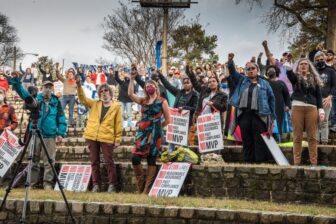Maryland was just hit by Hurricane Sandy, the largest storm ever recorded to hit the East Coast, but not as hard as states like New Jersey and New York:
“We all dodged a bullet on this one,” Anne Arundel County Fire Battalion Chief Steve Thompson said Tuesday from the county’s emergency operations center. “If that storm would have wiggled a little bit south, with those winds, it would have been a doozie.”
Yet, 300,000 people from Virginia to Baltimore remained without power Tuesday evening and many areas of the state experienced extensive flooding. The fishing pier on Ocean City’s iconic boardwalk is now half-gone. Sadly there were also a couple storm related deaths in Maryland as well as a number of injuries.
As we begin to rebuild, the first thing we must do is make sure everyone is safe and has what they need to survive in our state and across the country. Please donate if you can to the American Red Cross as they most certainly will need more robust funding in the coming years and decades.
Once we get back on our feet, with the metro running in DC and the subways back on track in New York City, we must immediately focus on what we can do to lessen the wrath of ever-worsening storms like Sandy. Perhaps Stephen Lacey and Joe Romm put it best when describing the link between human-caused climate change and these new super-storms:
“Like a baseball player on steroids, our climate system is breaking records at an unnatural pace. And like a baseball player on steroids, it’s the wrong question to ask whether a given home run is “caused” by steroids.”
The science is irrevocable that human beings are changing the climate by pumping loads of heat-trapping pollution into our atmosphere. If we continue at the pace we’re on now, storms like Hurricane Sandy will become more powerful and more frequent. We must change our energy policies and transition to a clean and more efficient energy system to mitigate the rise of seas and the strengthening of storms.
In Maryland, our #1 clean-energy/climate-progress solution is offshore wind power. Windmills installed starting 10 miles off the Maryland coast-line and going out for miles to sea could provide the equivalent of two-thirds our state’s electric load with current technology. As floating turbines and energy storage options advance, we could get two-and-a-half times our current electric load from offshore wind.
Given that stronger storms are now hitting the mid-Atlantic, it’s important to note that offshore wind turbines are built to withstand a category 3 hurricane and turbines have been operating in the seas of Europe since 1991. A 2012 Stanford University study found the area off the coast of Maryland to be low-risk to hurricanes as we’ve had none greater than a category 2 since 1851. As other studies have noted, advanced turbines will be built to withstand greater wind speeds for placement in higher risk areas. Ultimately, insurance for replacing turbine parts is included in the cost of offshore wind power, so any complications will not affect the locked-in power price for ratepayers.
All energy sources come with risks that must be factored into their cost. The risks to offshore wind farms are much less than the risk posed by nuclear power or by relying on fossil fuels that are cooking our planet. With Hurricane Sandy rolling through the mid-Atlantic, two nuclear plants had to be shut down and a third was put on alert as water levels reached too high at the facility. On the other hand, offshore wind turbines survived the terrible Japanese tsunami last year and Japan now plans to install floating turbines off the coast from the devastated Fukushimi nuclear facility.
Offshore wind turbines are sturdy, insurance is covered in the cost of the project, and ultimately they represent Maryland’s most abundant clean energy resource for mitigating the global climate crisis. With harsher storms becoming more frequent, the evidence supporting transitioning to this clean energy resource is stronger than ever.
If you live in Maryland and care about transitioning to clean energy to solve our climate crisis, here are some ideas on things to do over the next few weeks:
1) Stay safe as we come out from the high waters and dangerous winds.
2) Donate time or money to the American Red Cross to aid storm relief efforts.
3) Remember to vote next Tuesday or early!
4) Join CCAN director Mike Tidwell and MD State Senator Paul Pinsky on a statewide conference call on November 13th from 7-8pm to learn how you can help bring offshore wind power legislation across the finish line in 2013! This will be the third year of the campaign and it’s time to realize our most abundant clean energy resource!
Related Posts:
Superstorm Sandy




